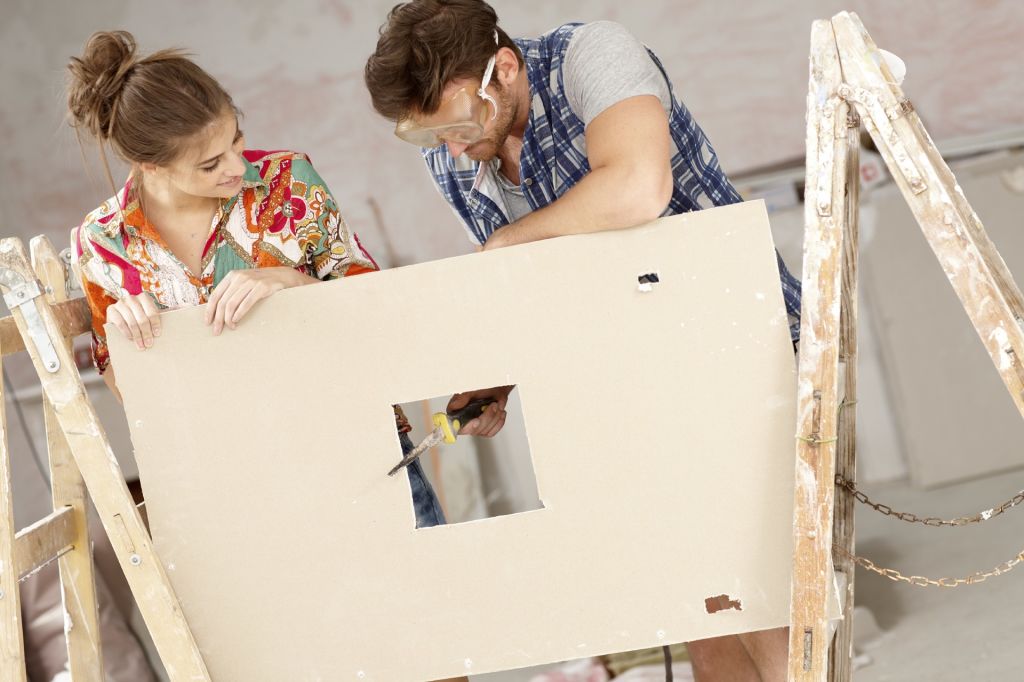Hands-on home renovation tips

The passion and the glory of personally transforming your home will provide hours of triumphant storytelling with fellow DIY renovators.
There are specific renovations that are a) most suited to the average homeowner and b) can add real value to your home. Domain research shows interior and exterior painting, landscaping (including decking) and bathroom alterations are the most common DIY projects Australian homeowners undertake.
Here we provide our top hands-on home renovation tips on Australia’s favourite renovation pastimes, as well as tiling, flooring and assembling a pre-fabricated kitchen.
Landscaping
Real estate agents will tell you that landscaping can add tens of thousands of dollars in value to your home. This is for a couple of reasons. First, great curbside appeal significantly increases buyer interest. Second, having a well-designed, low-maintenance backyard is high on most homeowners’ checklists. With this in mind, here are our top landscaping tips:
- Create a low-maintenance garden: Choose hardy plants suited to your local climate, pave instead of having lawn, and use ground cover or place plants close together to reduce weeding. Climbing vines can be a great way to cover unsightly walls or fencing and create the illusion of a garden wall.
- Design with privacy in mind: Privacy is a big selling factor and increases home value. Strategically plant vegetation that provides privacy but doesn’t hinder views, and ensure walls and fencing offer shelter from prying neighbours or passers-by.
- Build an outdoor entertaining area: As the costs of living rise, people are choosing to spend more time entertaining at home. Consider installing an outdoor shelter or decking to take advantage of Australia’s idyllic weather.
- Don’t forget utilities: Make sure hoses are within easy reach and there is room for conveniently locating the clothesline and bins.
- Go low-cost: The cheapest option is to do the manual work yourself, followed by borrowing or hiring equipment, and using recycled or reclaimed materials where possible.
Painting
Painting the interior or exterior of your home doesn’t cost much and makes a big visual impact. To ensure your paint job is enduring and does not require a premature touch-up, choose the right type of paint and follow the painting rules.
- Preparation is mandatory: If you do nothing else clean the surface with sugar soap, as this will help the paint adhere to the surface. You should also fill in holes and cracks, sand back inconsistent surfaces and scrape off old paint or wallpaper.
- Prime, seal or undercoat first: A recently painted surface may only require an undercoat, while other surfaces including exteriors, metal and wood will require a sealer or primer to provide grip for the top coat and durability. For wet areas and timber you should choose a primer that contains a fungicide to prevent the growth of mildew or mould.
- Choose your colour wisely: As a general rule, lighter, more neutral colours are best if you are selling your home. Otherwise go for colours that suit your décor and taste. Get some sample pots and apply a few patches to help you decide.
- Consider sheen levels: The sheen (or gloss) of a paint affects durability and reflection. Matte paints cover inconsistent surfaces better and the dense finish is great for large areas. Low-sheen and satin paints are more durable and suited to high traffic areas, while semi-gloss and gloss paints are generally used for trims, doors and detailing.
- Compare enamel and acrylic options. For exterior painting, enamel-based paints have been favoured as they dry harder. On the downside they can become brittle. Acrylic paints meanwhile, have increased in durability.
Tiling
If you are planning to tackle your own wall or floor tiling, we will assume you have some basic handyman skills in this area. Your local hardware store and tile supplier will also offer invaluable advice if you run into any problems. Some key pointers include:
- Choosing your tiles: Glass tiles expand and contract more so avoid using them in areas where the temperature will significantly change. You need to take into consideration how decorative patterns will work in the space, and pre-plan how you will manage cut edges and transitions in the tiles.
- Prepare your surface: Concrete bases must be completely dry, and you need to level out your surface as best as you can with a levelling compound or underlay. Chip away old mortar that may be present on old floors.
- Lay from the centre out: By working from the centre of the room, you can maximise the number of whole tiles you use and minimise those you need to cut for the finicky edges. Chalk out your tile layout first, beginning with a central line. Keep a close eye on tile spacing with a measurement tool – the more consistent the better. Lay the mortar or adhesive in sections so it doesn’t dry out, and gently press the tiles into place.
- Grout, clean and seal: Only apply the tile grout after the adhesive has dried, and the sealant after the grout has dried. When applying the grout, regularly wipe the tiles with a wet sponge to avoid permanent marks.
Polishing timber or concrete
While tiles and carpet are common flooring options, many people consider tearing up existing coverings to reveal a goldmine of untapped design features, including floorboards and bare concrete.
You can hire concrete grinders, sweepers, scrubbers and burnishers from suppliers like Kennards Hire. Ask as many questions as possible – different grinders are suited to different types of concrete, and there are both indoor and outdoor options.
To make the most of newly revealed timber floors or old timber floors that need a revamp, you will need to sand first and then stain. Timber sanders (and relevant advice) are available from hardware stores or equipment hire companies. In addition to the sander, you will need an edger to manage the sides of the room. Seal the area as thoroughly as possible and regularly vacuum to manage dust. You need to work through three stages of sanding – coarse, medium and fine – to obtain the best results.
Prefabricated flooring
Floating floors are low-cost, attractive and easy to install. For these reasons they are a renovator’s delight. Offering the appearance of timber, they can be made from laminate, bamboo, cork or engineered timber.
If you choose floating floors, it is important to factor in room for expansion when ordering and laying your flooring, particularly with bamboo styles. That said, bamboo is an environmentally sound, hard-wearing material. You will also need to place an underlay beneath your floating floor. The pre-fabricated pieces will slot together easily on top. They can be placed over virtually any surface, except carpet, but a moisture seal will be required and if your floors are concrete.
Assembling flat-pack kitchens
Purchasing a flat-pack kitchen can save you serious amounts of money, as can installing it yourself. This is another DIY renovation project that requires some handyman skill – think assembling an Ikea bookshelf … on steroids. Most suppliers provide online tools that will allow you to plan your kitchen virtually, taking into account room dimensions, appliances and power sources. You can choose between standardised flat-pack or customised kitchens, the latter of which are more costly.
- Over-prepare: From carefully planning out your design, to triple-checking your measurements, the more preparation you do, the better the result. Dwell on the variables like inconsistent floor and wall levels, weight-bearing, power sources, appliance sizes and the distance that cabinets and appliance doors require to open.
- Painstakingly review directions: Your kitchen comes pre-packaged withall the parts, fixtures, nuts and bolts and instructions. Check everything has arrived before you begin, and make sure the kitchen shell is ready for installation – you don’t want hold-ups mid-installation. Work slowly through the assembly steps and contact the supplier or a friend if you hit a flat-pack speed bump.
- Get the foundations right: Flat-pack kitchens are designed to fit together – this means each layer of the installation impacts the next layer’s stability and appearance. Carefully fasten fixtures as you go, and keep a spirit level handy to ensure consistency.
The laundry
There is nothing more impressive than walking into a well-organised, highly functional laundry that actually looks good. One of the most forgotten rooms in the house, a simple update can make this wet area a pleasure to use.
- Install storage: Hide cleaning products, appliances and dirty laundry behind sleek doors. Add extra storage in the laundry for general household items.
- Go light and bright: This is a room for cleaning, so keep colours fresh and use mould-resistant, hard-wearing paint that is durable and easily cleaned.
- Consider an extra lavatory or shower: Bathroom politics can be the root of all evil in an otherwise happy home. The laundry area already has plumbing and can provide an opportunity to add extra facilities.
Continue reading the DIY Home Renovation Guide with: Renovation safety plan and survival guide.
We recommend
We thought you might like
States
Capital Cities
Capital Cities - Rentals
Popular Areas
Allhomes
More







